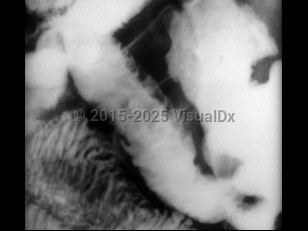Yersinia enterocolitica infection
Alerts and Notices
Important News & Links
Synopsis

Yersiniosis is an infectious disease caused by Yersinia species. This review will focus on the enteropathogenic yersiniae, Yersinia enterocolitica and Yersinia pseudotuberculosis, and exclude Yersinia pestis, the causative agent of plague. Both Y enterocolitica and Y pseudotuberculosis can cause enterocolitis and mesenteric adenitis, though Y pseudotuberculosis is more commonly associated with the latter. The vast majority of reported yersiniosis is due to Y enterocolitica.
Yersinia enterocolitica and Y pseudotuberculosis are pleomorphic non-lactose-fermenting gram-negative bacilli from the Enterobacteriaceae family. Yersiniosis is most commonly acquired through the consumption of contaminated food, especially undercooked pork products (eg, chitterlings). Disease has also occurred following consumption of unpasteurized dairy products, contact with infected animals, blood transfusion, and person-to-person fecal-oral transmission.
Children are more commonly affected by yersiniosis, particularly the enterocolitis syndrome due to Y enterocolitica, whereas mesenteric adenitis from Y pseudotuberculosis is seen more often in older children and adults. Yersiniosis is distributed throughout the world, though disease in the United States is less common than in other areas of the world.
Symptoms of infection due to enterocolitis include abdominal pain, diarrhea, and fever often lasting 1-3 weeks. Occasionally, nausea and vomiting may occur, and blood or mucus may be present in the stools. In the most serious cases, intestinal perforation or severe bleeding may occur. Yersinia pseudotuberculosis infection most commonly manifests with mesenteric adenitis, inflammation of the terminal ileum, and right lower quadrant abdominal pain that mimics acute appendicitis.
Extraintestinal manifestations of yersiniosis that have been described include reactive polyarthritis, exudative pharyngitis, erythema nodosum, and acute febrile neutrophilic dermatosis (Sweet syndrome). Septicemia due to Y enterocolitica or Y pseudotuberculosis is uncommon but severe, with 50%-75% mortality. Patients with immunocompromised status, elderly patients, and patients with iron overload are most often reported to have septicemia. Patients with iron overload receiving deferoxamine (an iron chelator) are at higher risk of septicemia, as this compound enhances the growth of Yersinia and inhibits leukocyte defenses against the organism. A variety of complications have been reported in patients with septicemia, including hepatic and splenic abscesses, osteomyelitis, mycotic aneurysms, and endocarditis.
Yersinia enterocolitica and Y pseudotuberculosis are pleomorphic non-lactose-fermenting gram-negative bacilli from the Enterobacteriaceae family. Yersiniosis is most commonly acquired through the consumption of contaminated food, especially undercooked pork products (eg, chitterlings). Disease has also occurred following consumption of unpasteurized dairy products, contact with infected animals, blood transfusion, and person-to-person fecal-oral transmission.
Children are more commonly affected by yersiniosis, particularly the enterocolitis syndrome due to Y enterocolitica, whereas mesenteric adenitis from Y pseudotuberculosis is seen more often in older children and adults. Yersiniosis is distributed throughout the world, though disease in the United States is less common than in other areas of the world.
Symptoms of infection due to enterocolitis include abdominal pain, diarrhea, and fever often lasting 1-3 weeks. Occasionally, nausea and vomiting may occur, and blood or mucus may be present in the stools. In the most serious cases, intestinal perforation or severe bleeding may occur. Yersinia pseudotuberculosis infection most commonly manifests with mesenteric adenitis, inflammation of the terminal ileum, and right lower quadrant abdominal pain that mimics acute appendicitis.
Extraintestinal manifestations of yersiniosis that have been described include reactive polyarthritis, exudative pharyngitis, erythema nodosum, and acute febrile neutrophilic dermatosis (Sweet syndrome). Septicemia due to Y enterocolitica or Y pseudotuberculosis is uncommon but severe, with 50%-75% mortality. Patients with immunocompromised status, elderly patients, and patients with iron overload are most often reported to have septicemia. Patients with iron overload receiving deferoxamine (an iron chelator) are at higher risk of septicemia, as this compound enhances the growth of Yersinia and inhibits leukocyte defenses against the organism. A variety of complications have been reported in patients with septicemia, including hepatic and splenic abscesses, osteomyelitis, mycotic aneurysms, and endocarditis.
Codes
ICD10CM:
A04.6 – Enteritis due to Yersinia enterocolitica
SNOMEDCT:
83436008 – Yersiniosis
A04.6 – Enteritis due to Yersinia enterocolitica
SNOMEDCT:
83436008 – Yersiniosis
Look For
Subscription Required
Diagnostic Pearls
Subscription Required
Differential Diagnosis & Pitfalls

To perform a comparison, select diagnoses from the classic differential
Subscription Required
Best Tests
Subscription Required
Management Pearls
Subscription Required
Therapy
Subscription Required
References
Subscription Required
Last Updated:03/03/2024

